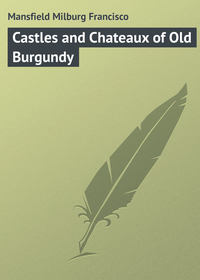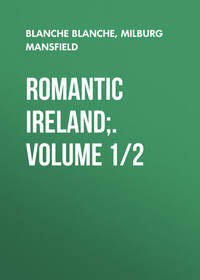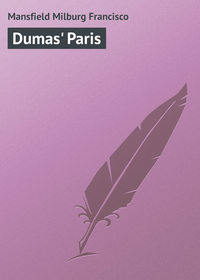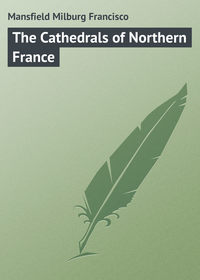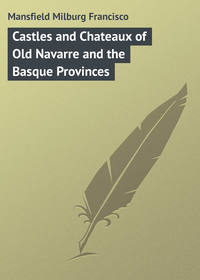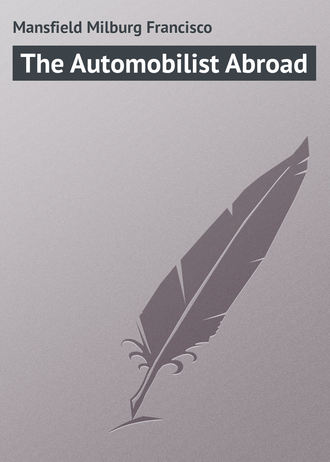 полная версия
полная версияThe Automobilist Abroad
One sees the thing every day on any of the great highroads in France leading from the Channel ports. One's destination may be the Pyrenees, the Cote d'Azur, Italy, or even Austria, and he does the intermediate steps at full speed. The same is true if he goes to Switzerland by the Rhine valley, or to Homburg by passing through Belgium or Holland. He might be just as well pleased with a fortnight in the Ardennes, or even in Holland or in Touraine, but, if his destination is Monte Carlo or Biarritz, he is not likely to linger longer by the way than the exigencies of food, drink, and lodging, and the care of his automobile demand.
When he has no objective point he loiters by the way and no doubt enjoys it the more, but it is not fair to put the automobilist down as a scorcher simply because he is pushing on. The best guide-books are caprice and fantasy, if you are hot pressed for time.
Mile-stones, or rather bornes kilométriques, line the roadways of Continental military Europe mercilessly, and it's a bad sign when the chauffeur begins to count them off. All the same, he knows his destination a great deal better than does some plodding tourist by rail who scorns him for rushing off again immediately after lunch.
One of the charms of travel, to the tried traveller, is, just as in the time of the Abbé Prévost, the ability to exchange remarks on one's itinerary with one's fellow travellers. In France it does not matter much whether they are automobilists or not. The commis-voyageur is a more numerous class here, apparently, than in any other country on the globe, and the detailed information which he can give one about the towns and hotels and sights and scenes en route, albeit he is more familiar with travel by rail than by road, is marvellous in quantity and valuable as to quality.
The automobile tourist, who may be an Englishman or an American, has hitherto been catered to with automobile novels, or love stories, or whatever one chooses to call them, or with more or less scrappy, incomplete, and badly edited accounts of tours made by some millionaire possessor of a motor-car, or the means to hire one. Some of the articles in the press, and an occasional book, have the merit of having been "good stuff," but often they have gone wrong in the making.
The writer of this book does not aspire to be classed with either of the above classes of able writers; the most he would like to claim is that he should be able to write a really good handbook on the subject, wherein such topographical, historical, and economic information as was presented should have the stamp of correctness. Perhaps four years of pretty constant automobile touring in Europe ought to count for something in the way of accumulated pertinent information concerning hotels and highways and by-ways.
Not all automobilists are millionaires. The man of moderate means is the real giver of impetus to the wheels of automobile progress. The manufacturers of motor-cars have not wholly waked up to this fact as yet, but the increasing number of tourists in small cars, both in England and in France, points to the fact that something besides the forty, sixty, or hundred horse-power monsters are being manufactured.
Efficiency and reliability is the great requisite of the touring automobile, and, for that matter, should be of any other. Efficiency and reliability cover ninety-nine per cent. of the requirements of the automobilist. Chance will step in at the most inopportune moments and upset all calculations, but, with due regard given to these two great and fundamental principles, the rest does not much matter.
It is a curious fact that the great mass of town folk, in France and probably elsewhere, still have a fear and dread of the mechanism of the automobile. "C'est beau la mécanique, mais c'est tout de même un peu compliqué," they say, as they regard your labours in posing a new valve or tightening up a joint here and there.
The development of the automobile has brought about a whole new development of kindred things, as did the development of the battle-ship. First there was the battle-ship, then the cruiser, and then the torpedo-boat, and then another class of boats, the destroyers (destined to catch torpedo-boats), and finally the submarine. With the automobile the evolution was much the same; first it was a sort of horseless carriage, for town use, then something a little more powerful that would climb hills, so that one might journey afield, and then the "touring-car," and then the racing machine, and now we have automobile omnibuses, and even automobile ambulances to pick up any frightened persons possessed of less agility than a kangaroo or a jack-rabbit might inadvertently have been bowled over. These disasters are seldom the automobilist's fault, and, happily, they are becoming fewer and fewer; but the indecision that overcame the passer-by, in the early days of the bicycle, still exists with many whenever an automobile comes in sight, and they back, and fill, and worry the automobilist into such a bad case of nerves that, in spite of himself, something of the nature of an accident, for which he is in no way responsible, really does happen.
Once the writer made eleven hundred kilometres straight across France, from the Manche to the Mediterranean, and not so much as a puncture occurred. On another occasion a little journey of half the length resulted in the general smashing up, four times in succession, of a little bolt (no great disaster in itself), within the interior arrangements of the motor, which necessitated a half a day's work on each occasion in taking down the cylinder and setting it up again, and each time in a small town far away from any properly equipped machine-shop, and with the assistance only of the local locksmith. It's astonishing how good a job a locksmith in France can do, even on an automobile, the mechanism of which he perhaps has never seen before. Officially the locksmith in France is known as a serrurier, but in the slang of the land he is the cambrioleur du pays, a name which is expressive, but which means nothing wicked. He can put a thread on a bolt or make a new nut to replace one that has mysteriously unscrewed itself, which is more than many a mere bicycle repairer can do.
The automobilist touring France should make friends with the nearest cambrioleur if he is in trouble. In England this is risky, a "gas-pipe thread" being the average lay workman's idea of "fixing you up."
Away back in Chaucer's day folk were "longen to gon on pilgrimages," and it does not matter in the least what the ways and means may be, the motive is ever the same: a change of scene.
This book is no unbounded eulogy of the automobile, although its many good qualities are recognized. There are other methods of travel that, in their own ways, are certainly enjoyable, but none quite equal the automobile for independence of action, convenience, and efficiency. It is well for all motor-car users, however, to realize that they are not the only road users, and to have a due regard for others, – not only their rights, but their persons. This applies even more forcibly, if possible, to the automobilist en tour.
One must in duty bound regulate his pace and his actions by the vagaries of others, however little he may want to, or unfortunate consequences will many times follow. Always he must have a sharp look ahead and must not neglect a backward glance now and then. He must not dash through muddy roads and splash passers-by (a particularly heinous offence in England), and in France he must observe the rule of the road (always to the right in passing, – no great difficulty for an American, but very puzzling to an Englishman), or an accident may result which will bring him into court, and perhaps into jail, unless he can assuage the poor peasant's feelings for the damaged forelegs of his horse or donkey by a cash payment on the spot.
Maeterlinck's "wonderful, unknown beast" is still unknown (and feared) by the majority of outsiders, and the propaganda of education must go on for a long time yet. Maeterlinck's great tribute to the automobile is his regard for it as the conqueror of space. Never before has the individual man been able to accomplish what the soulless corporations have with railway trains. In steamboat or train we are but a part and parcel of the freight carried, but in the automobile we are stoker, driver, and passenger in one, and regard every road-turning and landmark with a new wonder and appreciation.
We are the aristocrats of tourists, and we are bound therefore to have a kindly regard for other road users or a revolution will spring up, as it did in feudal times.
Take Maeterlinck's wise sayings for your guide, and be tolerant of the rights of others. This will do automobilism more good than can be measured, for it has come to stay, and perhaps even advance. The days of the horse are numbered.
"In accord with the needs of our insatiable, exacting soul, which craves at once for the small and the mighty, the quick and the slow; here it is of us at last, it is ours, and offers at every turn glimpses of beauty that, in former days, we could only enjoy when the tedious journey was ended."
The "tour abroad" has ever been the lodestone which has drawn countless thousands of home-loving English and Americans to Continental Europe. Pleasure – mere pleasure – has accounted for many of these pilgrims, but by far the largest proportion have been those who seek education and edification combined.
One likes to be well cared for when he journeys, whether by road or rail, and demands accordingly, if not all the comforts of home, at least many things that the native knows or cares little of. A Frenchman does not desire a sitting-room, a reading-room, or a fire in his sleeping-room, and, according to his lights, he is quite right. He finds all this at a café, and prefers to go there for it. The steam-heated hotel, with running water everywhere, is a rarity in France, as indeed it is in England.
Outside Paris the writer has found this combination but seldom in France; at Lyons, Marseilles, Moulins in the Allier, and at Chatellerault in Poitou only. Modernity is making its way in France, but only in spots; its progress is steady, but as yet it has not penetrated into many outlying districts. Modern art nouveau ideas in France, which are banal enough, but which are an improvement over the Eastlake and horsehair horrors of the Victorian and Louis-Philippe periods, are tending to eliminate old-fashioned ideas for the benefit of the traveller who would rather eat his meals in a bright, airy apartment than in stuffy, dark hole known in England as a coffee-room.
In France, in particular, the contrast of the new and old that one occasionally meets with is staggering. It is all very well in its way, this blending of antiquity and modernity, and gives one something of the thrill of romance, which most of us have in our make-up to a greater or lesser extent; but, on the other hand, romance gets some hard knocks when one finds a Roman sarcophagus used as a watering-trough; or a chapel as an automobile garage, as he often will in the Midi.
One thing the American, and the Britisher to a lesser extent, be he automobilist or mere tourist, must fully realize, and that is that the tourist business is a more highly developed industry in Continental Europe than it is anywhere else. In Switzerland one may well say that it is a national industry, and in some parts of France (always omitting Paris, which is not France) it is practically the same thing; Holland and Belgium are not far behind, and neither is the Rhine country; so that the tourist in Europe finds that creature comforts are always near at hand. The automobilist does not much care whether they are near at hand or not. If he doesn't find the accommodations he is looking for on the borders of Dartmoor, he can keep on to Exmoor, and if Nevers won't suit his purpose for the night he can get to Moulins in an hour.
A hotel that is full and overflowing is no more a fear or a dread; the automobilist simply takes the road again and drops in on some market-town twenty, thirty, or fifty miles away and finds accommodations that are equally satisfactory, with the possibility – if he looks in at some little visited spot like Meung or Beaugency in Touraine, Ecloo in Holland, or Reichenberg on the Rhine – that he will be more pleased with his surroundings than he would be in the large towns which are marked in heavy-faced type in the railway guides, and whose hotels are starred by Baedeker.
In most countries the passport is no longer a necessary document in the traveller's pocketbook, though the Britisher still fondly arms himself with this "protection," and the American will, if it occurs to him, be only too glad to contribute his dollars to the fees of his consulate or embassy in order to possess himself of a gaudy thing in parchment and gold which he can wave in front of any one whom he thinks transgresses his rights as an American citizen: "from the land of liberty, and don't you forget it."
This is all very well and is no doubt the very essence of a proper patriotism, but the best pièce d'identité for the foreigner who takes up his residence in France for more than three months is a simple document which can be obtained from the commissaire de police. It will pass him anywhere in France that a passport will, is more readily understood and accepted by the banker or post-office clerk as a personal identification, and will save the automobile chauffeur many an annoyance, if he has erred through lack of familiarity with many little unwritten laws of the land.
The automobilist en tour always has the identification papers of his automobile; in England his "License," and in France his "Certificat de Capacité" and "Récépisse de Déclaration," which will accomplish pretty much all the passport of other days would do if one flourished it to-day before a stubborn octroi official or the caretaker of a historical monument.
The membership card of the Italian, Swiss, or French touring clubs will do much the same thing, and no one should be without them, since membership in either one or all is not difficult or costly. (See Appendix.)
France is the land par excellence for the tourist, whether by road or rail. The art of "le tourisme" has been perfected by the French to even a higher degree than in Switzerland. There are numerous societies, clubs, and associations, from the all-powerful Touring Club de France downward, which are attracting not only the French themselves to many hitherto little-known corners of "la belle France," but strangers from over the frontiers and beyond the seas. These are not the tourists of the conventional kind, but those who seek out the little-worn roads. It is possible to do this if one travels intelligently by rail, but it is a great deal more satisfactorily done if one goes by road.
Here and there, scattered all over France, in Dauphiné, in Savoie, and in the Pyrenees, one finds powerful "Syndicats d'Initiative," which not only care for the tourist, but bring pressure to bear on the hotel-keeper and local authorities to provide something in the way of improvements, where they are needed, to make a roadway safe, or to restore a historical site or monument.
In the Pyrenees, and in the Alps of Savoie and Dauphiné, one finds everywhere the insignia of the "Club-Alpin Français," which caters with information, etc., not only to the mountain-climber, but to the automobilist and the general tourist as well.
More powerful and effective than all – more so even than the famous Automobile Club de France – is the great Touring Club de France, which, with the patronage of the President of the Republic, and the influence of more than a hundred thousand members, is something more than a mere touring club.
In the fourteen years of its existence not only has the Touring Club de France helped the tourist find his way about, but also has taken a leading part in the clearing away of the debris in many a moss-grown ruin and making of it a historical monument as pleasing to view as Jumièges on the Seine, or world-famed Les Baux in Provence.
It has appointed itself the special guardian of roads and roadways, so far as the placing of signboards along the many important lines of communication is concerned; it has been the means of having dug up untold kilometres of Renaissance pavement; has made, almost at its own expense, a magnificent forty-kilometre road known as the Corniche de l'Esterel; and has given the backward innkeeper such a shock that he has at last waked up to the needs of the twentieth-century traveller. All this is something for a touring organization to have accomplished, and when one can become a part and parcel of this great organization, and a sharer in the special advantages which it has to offer to its members for the absurdly small sum of five francs per annum, the marvel is that it has not half a million members instead of a hundred thousand.
Chapter III
Roads & Routes
The chief concern of the automobilist to-day, after his individual automobile, is the road question, the "Good Roads Question," as it has become generally known. In a new country, like America, it is to be expected that great connecting highways should be mostly in the making. It is to be regretted that the development should be so slow, but things have been improving in the last decade, and perhaps America will "beat the world" in this respect, as she has in many others, before many future generations have been born.
In the excellence and maintenance of her roads France stands emphatically at the head of all nations, but even here noticeable improvement is going on. The terrific "Louis Quatorze pavé," which one finds around Paris, is yearly growing less and less in quantity. The worst road-bed in France is that awful stretch from Bordeaux, via Bazas, to Pau in Navarre, originally due to the energy of Henri IV., and still in existence for a space of nearly a hundred kilometres. One avoids it by a détour of some twenty odd kilometres, and the writer humbly suggests that here is an important unaccomplished work for the usually energetic road authorities of France.
After France the "good roads" of Britain come next, though in some parts of the country they are woefully inadequate to accommodate the fast-growing traffic by road, notably in London suburbs, while some of the leafy lanes over which poets rhapsodize are so narrow that the local laws prevent any automobile traffic whatever. As one unfortunate individual expressed it, "since the local authorities forbid automobiles on roadways under sixteen feet in width, I am unable to get my motor-car within nine miles of my home!"
In England something has been done by late generations toward roads improvement. The first awakening came in 1820, and in 1832 the London-Oxford road had been so improved that the former time of the stage-coaches had been reduced from eight to six hours. Macadam in 1830, and Stevenson in 1847, were the real fathers of the "Roads Improvement Movement" in England. The great faults of English roads are that they are narrow and winding, almost without exception. There are 38,600 kilometres of highways (the figures are given on the metric scale for better comparison with Continental facts and figures) and 160,900 of by-roads. There are sixty-six kilometres of roads to the square kilometre (kilometre carré).
In Germany the roads system is very complex. In Baden, the Palatinate, and the Grand Duchy of Hesse they cede nothing to the best roads anywhere, but in the central and northern provinces they are, generally speaking, much poorer. There are fifty-four kilometres of roads of all grades to the kilometre carré.
In Belgium the roads are greatly inferior to those of France, and there are immeasurable stretches of the vilest pavement the world has known, not only near the large towns, but great interior stretches as well. There are 17,500 kilometres of Chemins Vicinaux and 6,990 kilometres of Chemins de Grands Communications. They average, taken together, eighty-three kilometres to the kilometre carré.
In Switzerland the roads are thoroughly good everywhere, but many, particularly mountain-roads, are entirely closed to automobile traffic, and the regulations in many of the towns are so onerous that it is anything but agreeable to make one's way through them. There are thirty-two kilometres to the kilometre carré. The Simplon Pass has only recently (1906) been opened to automobile traffic. No departure can be made from Brigue, on the Swiss side, or from Gondo, in Italy, after three P.M. Speed (vitesse) must not exceed ten kilometres on the stretches, or two kilometres around the corners. Fines for infringement of the law run from twenty to five hundred francs.
Italy, with a surface area one-half that of France, has but a quarter of the extent of the good roads. They are of variable quality, but good on the main lines of travel. In the ancient kingdom of Sardinia will be found the best, but they are poor and greatly neglected around Naples, and, as might be expected, in Sicily.
In Austria the roads are very variable as to surface and maintenance, and there are numerous culverts or canivaux across them. There are 21,112 kilometres of national roads, 66,747 kilometres of provincial roads, and 87,859 of local roads. They average fourteen kilometres to the kilometre carré.
The history of the development of the modern roadway is too big a subject to permit of its being treated here; suffice it to recall that in England and France, and along the Rhine, the lines of the twentieth-century main roads follow the Roman roads of classic times.
In France, Lyons, in the mid-Rhône valley, was a great centre for the radiating roadways of Gaul. Strategically it was important then as it is important now, and Roman soldiery of the past, as the automobilist of to-day, had here four great thoroughfares leading from the city. The first traversed the valleys of the Rhine and the Meuse; the second passed by Autun, Troyes, Chalons, Reims, Soissons, Noyon, and Amiens; the third branched in one direction toward Saintes, and in another to Bordeaux; while the fourth dropped down the Rhône valley direct to Marseilles.
More than thirty thousand kilometres of roadways were in use throughout Gaul during the Roman occupation, of which the four great routes (viæ publicæ) formed perhaps four thousand.
Of the great highways of France, the Grandes Routes Nationales, of which all travellers by road have the fondest and most vivid memories, it is well to recall that they were furthered, if not fathered, by none other than Napoleon, who, for all he laid waste, set up institutions anew which more than compensated for the destructions.
The great roadways of France, such as the Route de Bretagne, running due west from the capital, and those leading to Spain, Switzerland, Italy, and the Pays Bas, had their origin in the days of Philippe-Auguste. His predecessors had let the magnificently traced itineraries of the Romans languish and become covered with grass – if not actually timber-grown.
The arrangement and classification laid down by Philippe-Auguste have never been changed, simply modified and renamed; thus the Routes Royales– such as followed nearly a straight line from Paris by the right bank of the Loire to Amboise and to Nantes – became the Routes Nationales of to-day.
Soon wheeled traffic became a thing to be considered, and royal cortèges moved about the land with much the same freedom and stateliness of the state coaches which one sees to-day in pageants, as relics of a past monarchical splendour.
Louis XI. created the "Service des Postes" in France, which made new demands upon the now more numerous routes and roadways, and Louis XII., François I., Henri II., and Charles IX., all made numerous ordinances for the policing and maintenance of them.
Henri IV., and his minister Sully, built many more of these great lines of communication, and thus gave the first real and tangible aid to the commerce and agriculture of the kingdom. He was something of an aesthetic soul too, this Henri of Bearn, for he was the originator of the scheme to make the great roadways of France tree-shaded boulevards, which in truth is what many of them are to-day. This monarch of love, intrigues, religious reversion, and strange oaths passed the first (and only, for the present is simply a continuance thereof) ordonnance making the planting of trees along the national highroads compulsory on the local authorities.




